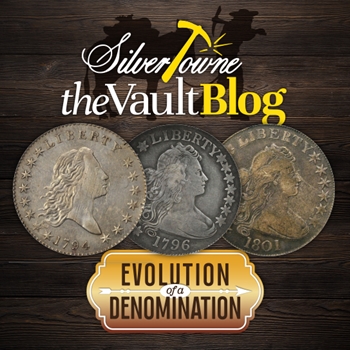
Perhaps one of the most popular denominations in United States coinage history is one that is no longer really seen in circulation today, although it is not impossible to see one every now and then. However, the role it played many years ago was one that was essential to American commerce and the nation’s coinage system. While its demand has lessened over the years, let us take you back to when the half dollar was first introduced as part of the authorization of the Act of April 2, 1792.
Flowing Hair (1794-1795)
Although authorized in 1792, the half dollar was not minted until December of 1794 as it was one of three denominations to be issued in silver (.8924 to be exact). While the dollar was the first silver coin to ever have been produced, it proceeded to cause more issues than not for the United States Mint. The press could not handle the size of the coins and left it often broken down. Fewer than 1,800 pieces were produced of the silver dollar and they were less than suitable. The production was suspended and the Mint turned to making half dollars with the first batch of 5,300 being minted on December 1, 1794.
The entire Flowing Hair half dollar design saw a total of approximately 323,144 produced. Engraved by Chief Engraver of the United States Mint, Robert Scot, the obverse design features a right facing portrait of Liberty as “LIBERTY” appears above her and the date appears below her. Fifteen stars are seen surrounding the design to reflect the number of states that were a part of the Union at the time. The reverse features a small eagle perched on a rock with its wings spread out. Laurel branches and the inscription “UNITED STATES OF AMERICA” surround it with the edge featuring the inscription “FIFTY CENTS OR HALF DOLLAR” in addition to decorations between the words.
Draped Bust, Small Eagle Reverse (1796-1797)
In early U.S. coinage days, it was not uncommon for designs to change at the drop of a hat. The Mint took criticism personally and was always trying to please the public with the right designs and representation of a very brand new nation. Early silver coinage would prove this as the half dollar was one that was quickly changed and went through three different designs in its first decade. The Flowing Hair design that began in 1794 and ran through 1795 was replaced by a more mature portrait of Liberty. This was known as the Draped Bust design.
Surrounded by 16 stars at first in 1796 as Tennessee was admitted to the Union, the design quickly changed back to 15 in 1797 as dies were prepared in advance. The reverse was similar to the Flowing Hair reverse, just slightly altered. The eagle became more “graceful” and the fraction “½” was added below the wreath. Struck with just two dates, 1796 and 1797, the mintage of the half dollar with the Small Eagle reverse was very small. Approximately 3,918 pieces were struck between both years.
Draped Bust, Heraldic Eagle Reverse (1801-1807)
Part of the reason that the Mint produced so few half dollars in 1796 and 1797 was because they focused on silver dollars and smaller silver coins at the time. After the Draped Bust, Small Eagle Reverse half dollar, they quit making half dollars altogether until it would return in 1801. This time, the reverse would see yet another change in the Heraldic Eagle design. The eagle was much larger and featured a shield upon its breast. Although technically speaking, this series was short lived as well even though mintage numbers were greater than any of the previous years.
The obverse design featured just 13 stars reflecting the thirteen original colonies. The eagle on the reverse was modeled after the one that appears on the nation’s Great Seal. A ribbon hangs from its beak, bearing the motto “E PLURIBUS UNUM.” In its first year back, 30,289 coins were struck. From 1801 to 1807 with no mintage for 1804, a little over 1.6 million half dollars were produced with the Heraldic Eagle reverse.
Source: NGC Coin; The Official 2023 Red Book







